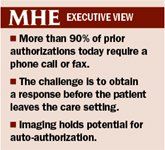Manage medical advances with automated prior authorization
Standardized medical policies, appropriate technology, centralized authorization tools can render a decision before the patient leaves the clinic
GIVEN CONTINUING cost increases, the healthcare system must replace inefficient manual processes with technology-based solutions wherever possible. Prior authorizations are a case-in-point.
Disliked by physicians because they are time-consuming and might force changes in treatment plans, preauthorization programs are regaining popularity among health plans as they strive to manage medical advances. However, more than 90% of prior authorizations require a phone call or faxed request, at an estimated cost to the plan of $75 for each authorization.
Plans are willing to incur these costs because the alternative is paying even more for unnecessary services.
There are dynamic challenges that must be managed if healthcare is to automate prior authorization. The three major categories are: medical policies, medical technology assessments, and the tools used for authorization processes.
Medical policies-The rules that define what medical services are covered are seldom fully automated, and although evidence-based medicine is at the heart of medical policies, there are no standards to define policy terms. Keeping medical policies up-to-date is resource-intensive, so few reflect the latest advances. Most plans make their medical policies available via their portals where providers and consumers may read the policy to try to figure out if a treatment is covered.
But, these policies are hard to interpret and seldom link effectively to patient management or even to claims payment policies. The challenge is to standardize policy definitions and make them available for access during an automated authorization process and thereafter.
Medical technology assessments-The evaluation processes used to determine whether a new medical technology should be a covered service are also predominantly manual. In addition to verifying that the technology has been approved, the plan needs to know that it is supported by rigorous, evidence-based studies, and that it's at least as effective as existing treatments or therapies. Collecting and evaluating the information relevant to a technology assessment takes time and clinical expertise. Unless you have a large clinical staff dedicated to technology assessments, you cannot hope to keep up with the pace of change in medical technology.
Molecular diagnostics, for example, is an exploding field. Last year, total expenditures for these advanced tests amounted to $5.5 billion, and that's expected to grow to $8 billion by 2012, driven by growth in utilization and availability, according to Washington G-2 Reports, "Business Strategies for Molecular Diagnostics Labs," 2008. These are often very expensive tests ranging from $300 to more than $1,000, frequently marketed directly to consumers. While advanced tests can be an important tool in deciding a course of treatment, they are only useful for certain patients. The challenge is to create patient-centric, interactive, highly efficient decision trees to assess appropriateness during the authorization process.
The challenge of assessing appropriateness of new technologies is not just about new tests in the clinical laboratory. It's also about imaging technology, durable medical equipment, chemotherapy, organ transplantation, prosthetic limbs, brain stimulators, brain suppressors, etc. Physicians and patients need to know what is covered or not covered before an intervention is ordered and before starting a treatment course, which may not be covered or may be prohibitively expensive.

The challenge is to return a response to routine authorization requests before the patient has departed the clinic.
Doing More and Saving More with Primary in Home Care
September 1st 2021In this week’s episode of Tuning In to the C-Suite podcast, MHE Associate Editor Briana Contreras interviewed VillageMD’s Senior Medical Director of Village Medical at Home, Dr. Tom Cornwell. Dr. Cornwell discussed the main benefits of primary care at home, which includes the benefit of cost savings for patients, maintaining control of hospital readmissions and others. Dr. Cornwell also noted what has changed in the industry of at-home care and if there has been interest from payers like insurance companies and medicare in the service.
Listen
Doing More and Saving More with Primary in Home Care
September 1st 2021In this week’s episode of Tuning In to the C-Suite podcast, MHE Associate Editor Briana Contreras interviewed VillageMD’s Senior Medical Director of Village Medical at Home, Dr. Tom Cornwell. Dr. Cornwell discussed the main benefits of primary care at home, which includes the benefit of cost savings for patients, maintaining control of hospital readmissions and others. Dr. Cornwell also noted what has changed in the industry of at-home care and if there has been interest from payers like insurance companies and medicare in the service.
Listen
2 Commerce Drive
Cranbury, NJ 08512
All rights reserved.